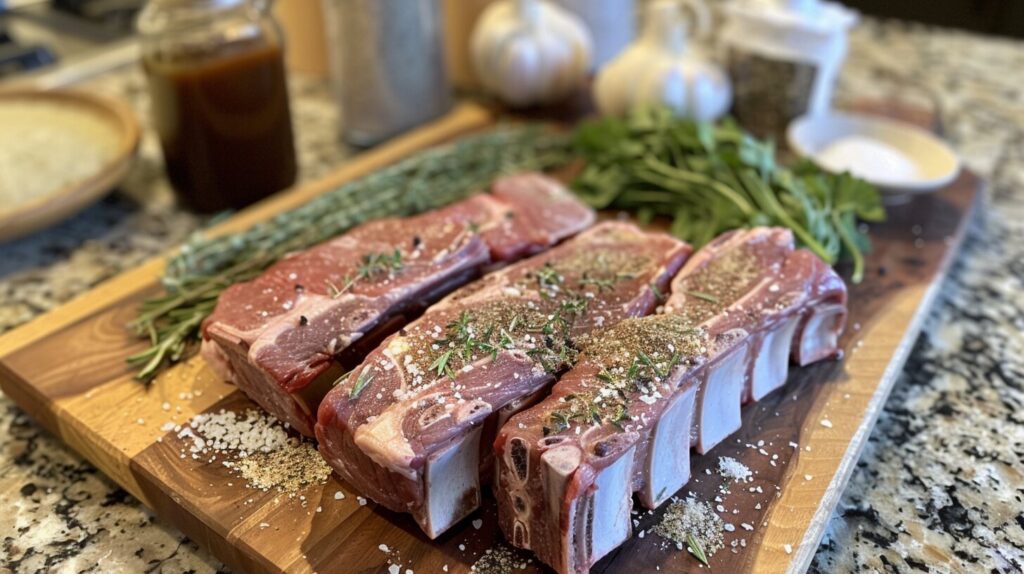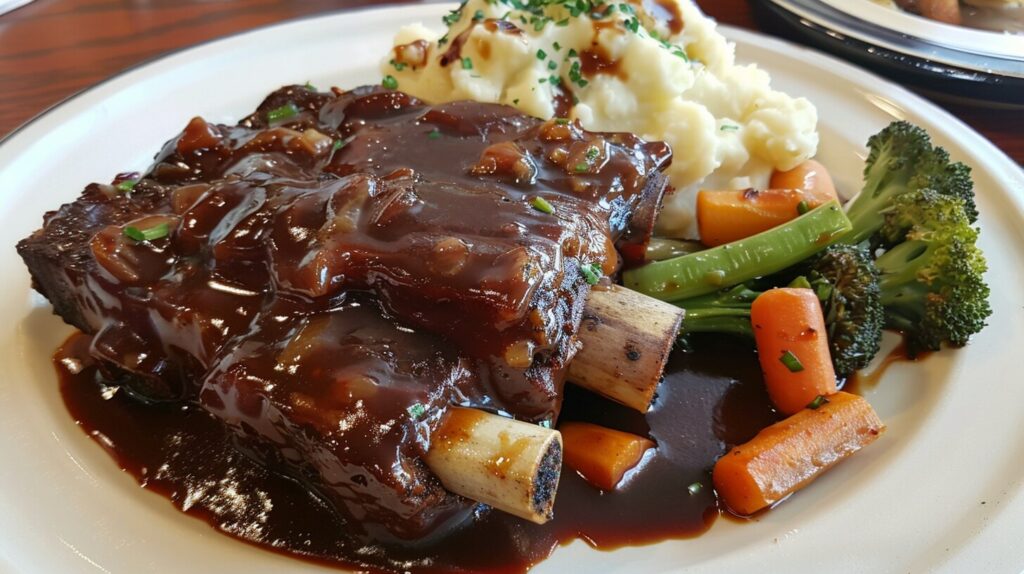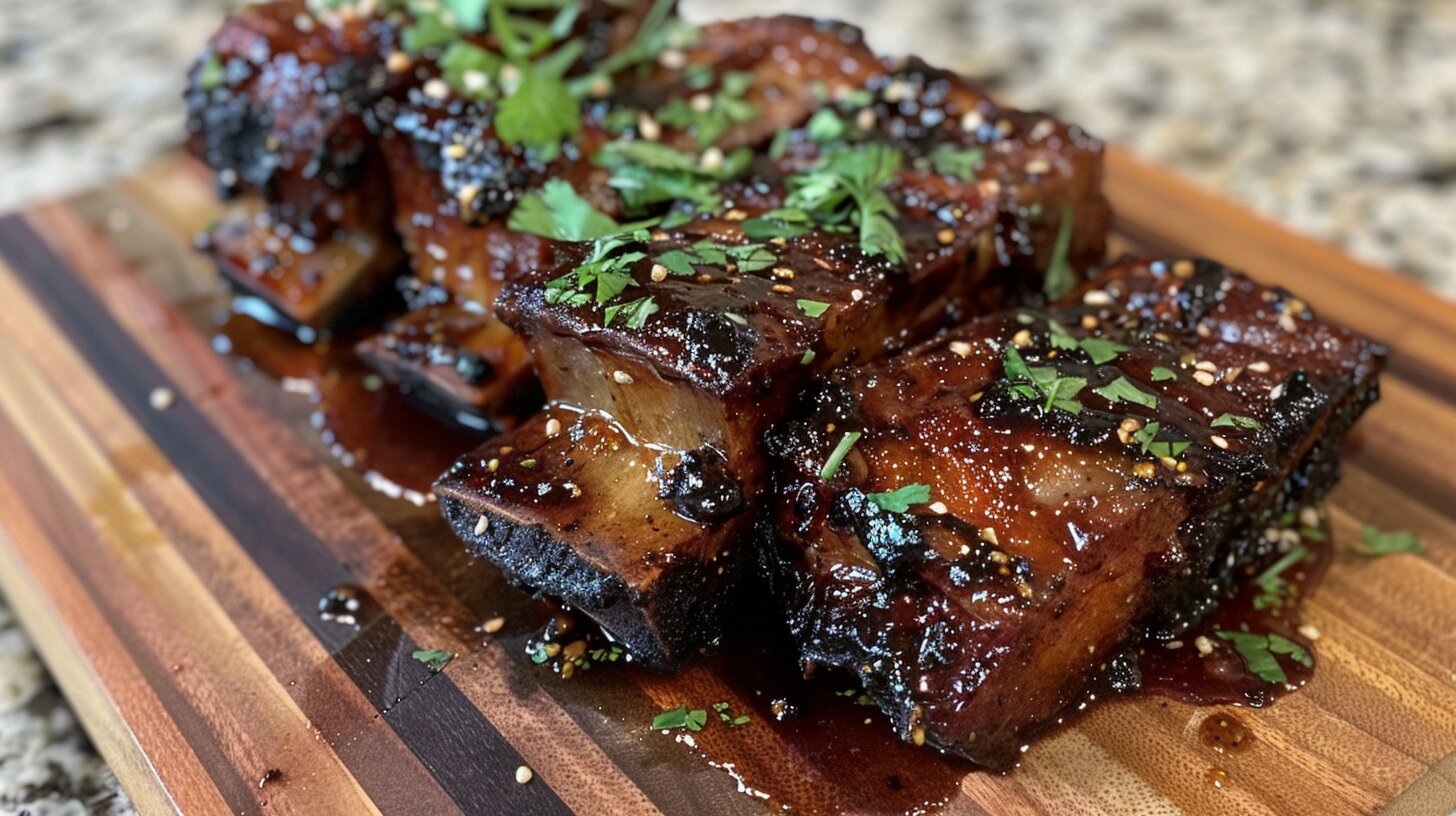Table of Contents
Short ribs are a popular cut of beef due to their flavorful and delicious texture when cooked correctly. But when tackling this dish, many home cooks wonder: does short rib get more tender the longer it cooks?
The question, “Do short ribs get more tender as they cooks?” is in understanding the ribs’ distinctive shape and the cooking techniques best suited to dissolve their connective tissues. This article explores the science of tenderness, various cooking techniques, and tips for avoiding common mistakes when preparing short ribs. By the end, you’ll know precisely why short ribs get more tender the longer they cook and how to ensure perfectly cooked, melt-in-your-mouth results every time.
Understanding Short Ribs

What Are Short Ribs and Why Does Cooking Time Matter?
Short ribs are a cut of beef taken from the animal’s brisket, chuck, plate, or rib areas. They consist of a brief portion of the rib bone and a thick layer of meat, including intermuscular fat and connective tissue.
There are two significant kinds of short ribs:
- English-Cut Short Ribs: These are cut parallel to the bone, leaving a thick chunk of meat on each bone.
- Flanken-Cut Short Ribs: These are cut across the bone, resulting in thin strips with small pieces of bone interspersed.
Each style suits different cooking methods, with English cut ideal for slow, moist cooking and flanken-cut often used in grilling or braising.
Do Short Ribs Get Tender With Longer Cooking Times?
Short ribs are famous for their flavorful and tenderness when cooked correctly. They are also a good source of protein, iron, and other essential nutrients, though their high-fat content requires careful preparation to avoid greasiness.
Cooking short ribs is all about patience and proper technique. Let’s examine the scientific basis for their transformation into soft, delicious bites.
The Science Behind Short Rib Tenderness: Does It Get Better with Time?
Does Collagen Breakdown Make Short Ribs More Tender Over Time?
The secret to tender short ribs lies in their composition. Short ribs are awash in collagen, which is a kind of connective tissue that holds the muscle fibers. When heat exposure, collagen breaks into gelatin, giving the meat a silky, melt-in-your-mouth texture.
However, this transformation doesn’t happen instantly. Collagen requires time and the right temperature to dissolve effectively. Cooking short ribs too quickly can leave them tough and chewy, while slow, moist cooking allows collagen to break down entirely.
What Happens to Meat When Cooked Over Time?
As the meat cooks, several processes occur:
- Protein Denaturation: Proteins in the muscle fibers unravel, making the meat firm.
- Fat Rendering: Fat melts, enhancing flavor and moisture.
- Collagen Breakdown: At temperatures around 160–205°F (70–96°C), collagen converts into gelatin, softening the meat.
Cooking short ribs for a longer time at a low temperature ensures these processes occur entirely, resulting in tender, flavorful meat. However, overcooking can cause the meat to dry out, emphasizing the importance of balancing time and temperature.
Best Cooking Methods for Tender Short Ribs: Does Longer Cooking Help?

Does Braising Make Short Ribs More Tender Over Time?
The most sought-after method of the preparation of short ribs. This technique involves simmering the meat in a small amount of liquid, such as broth, wine, or beer, at low temperatures. The moist environment and prolonged cooking time allow the collagen to dissolve completely.
Steps to Braise Short Ribs:
- Sear the Meat: Brown the short ribs in a hot pan with oil to develop a flavorful crust.
- Prepare the Braising Liquid: Combine your choice of liquid with aromatic vegetables (e.g., onions, carrots, and celery), garlic, and herbs.
- Slow Cook: Place the meat and liquid in a covered Dutch oven or slow cooker and cook at 275°F (135°C) for 3–4 hours.
- Rest and Serve: Let the meat rest in the braising liquid for 10–15 minutes before serving.
Alternative Methods: Smoking, Slow Cooking, and Sous Vide
- Smoking: Slow smoking at a low temperature (225°F or 107°C) infuses short ribs with a smoky flavor while breaking down connective tissue.
- Slow Cooking: A slow cooker offers convenience, allowing you to “set it and forget it.” Cooking on low heat for 6–8 hours typically yields tender results.
- Sous Vide: Sous vide is a precision cooking technique where short ribs are vacuum-sealed and cooked in a water bath at a specific temperature (e.g., 165°F or 74°C) for 24–48 hours, ensuring consistent tenderness.
Each method has benefits, but braising remains the most foolproof way to achieve tender short ribs.
Factors That Affect Tenderness
Cooking Time vs. Overcooking
Short ribs cooked for long periods of time are essential in dissolving connective tissue and collagen; however, it is important not to overcook the ribs. When left on heat too long, the meat’s moisture can evaporate, leading to a dry and stringy texture.
Optimal Cooking Times:
- Braising: 3–4 hours at 275°F (135°C).
- Slow Cooker: 6–8 hours on low heat.
- Sous Vide: 24–48 hours at 165°F (74°C).
Maintaining the right balance ensures the meat is tender and succulent without losing its juiciness.
Heat Level and Moisture Retention
Slow and low is the ideal recipe for short ribs. High heat can cause the outer layer to overcook before the inner connective tissue breaks down. A gentle, consistent heat ensures the meat cooks evenly, while moisture from the braising liquid or cooking environment prevents it from drying out.
Tip: Always keep the cooking vessel covered to retain moisture.
Meat Quality and Marbling
The quality of the meat also influences tenderness. Short ribs with good marbling (the intramuscular fat running through the meat) produce a more tender and flavorful result. Marbling helps the meat stay moist during the long cooking process.
Choosing Quality Short Ribs:
- Find USDA Grades of Choice or Prime to get the best marbling.
- Opt for fresh short ribs over frozen, as freezing can sometimes alter the texture.
Common Mistakes to Avoid
Overcooking or Undercooking
While undercooking prevents the collagen from breaking down, overcooking can cause the meat fibers to tighten excessively, squeezing out moisture and leaving the meat dry.
How to Avoid:
- Use a thermometer for meat to check the temperature inside your meat. Aim for 190–205°F (88–96°C) for braising.
- Verify the doneness of the meat by inserting forks in the meat. If it slides out quickly, the ribs are ready.
Not Searing the Meat
A missed searing step could cause a blander dish. Searing caramelizes the surface of the meat, creating a depth of flavor that enhances the final dish.
Searing Tips:
- Use a heavy skillet or Dutch oven for even browning.
- Sear on high heat for 2–3 minutes per side before braising or slow cooking.
Using the Wrong Liquid or Seasoning
The choice of braising liquid and seasonings significantly affects the final flavor. Using a bland liquid or failing to season adequately can result in underwhelming short ribs.
Flavorful Liquid Options:
- Red wine, beef stock, or beer.
- Add herbs like thyme, rosemary, or bay leaves.
Summary of Key Factors
To achieve perfectly tender short ribs:
- Cook low and slow.
- Use a well-marbled cut.
- Sear the meat and choose a flavorful braising liquid.
Practical Tips for Cooking Short Ribs
Season Generously
Short ribs benefit from bold flavors. Season with salt and pepper before searing, and consider using a spice rub or marinade for added depth.
Rest Before Serving
Allow short ribs to rest in the cooking liquid for 10–15 minutes before serving. This step helps the meat retain moisture and lets the flavors meld.
Strain and Reduce the Sauce
After removing the short ribs from the braising liquid, strain out the solids and simmer the liquid until it thickens into a rich sauce. Drizzle this over the ribs for added flavor.
Exploring Cooking Methods for Perfect Short Ribs
Braising: The Classic Method
Braising remains the go-to technique for achieving tender, flavorful short ribs. The method combines dry and moist heat: the meat is first seared to develop flavor and then slow-cooked in liquid, which breaks down connective tissue and infuses the ribs with moisture.
Key Braising Steps:
- Sear the Ribs: Heat oil in a heavy-bottomed pot and brown the short ribs on all sides. This step develops a rich, caramelized crust.
- Prepare the Aromatics: Sauté onions, carrots, and celery in the same pot. Add garlic, tomato paste, or spices to build complexity.
- Add the Liquid: Deglaze the pot with wine, stock, or beer, scraping up browned bits for added flavor. Return the ribs to the pot and add herbs like thyme or bay leaves.
- Slow Cook: Cover and cook in the oven or stovetop at low heat (around 275°F/135°C) for 3–4 hours.
Why It Works:
The low heat allows the collagen to transform into gelatin without overcooking the muscle fibers, resulting in a tender, fall-apart texture.
Slow Cooking: A Convenient Alternative
The slow cooker provides a hands-off way to tenderize short ribs. Like braising, this method cooks the meat at a low, steady temperature over several hours.
Slow Cooking Tips:
- Set the cooker to low heat for 6–8 hours for optimal tenderness.
- Use a robust liquid, like wine or broth, to add depth to the dish.
- Avoid lifting the lid during cooking, as this releases heat and moisture.
Smoking for a Unique Flavor Profile
Smoking short ribs at a low temperature (225°F/107°C) creates a rich, smoky flavor. While it doesn’t involve liquid like braising, prolonged exposure to low heat tenderizes the meat over time.
Smoking Tips:
- Use wood like hickory or oak for a deep, smoky taste.
- Wrap the ribs in foil after the first few hours to retain moisture.
- Serve with a BBQ glaze or sauce for added flavor.
Sous Vide: Precision Cooking for Tenderness
Sous vide involves vacuum-sealing short ribs and cooking them in a water bath at a precise temperature for an extended period. This method ensures even cooking and preserves the meat’s natural juices. One of the most significant advantages is that sous vide makes it nearly impossible to overcook short ribs, ensuring perfect tenderness every time.
Typical Sous Vide Process:
- Cook short ribs at 165°F (74°C) for 24–48 hours for a tender result.
- Finish by searing the ribs in a hot pan or under the broiler for a crispy exterior.
Advantages:
Sous vide offers unparalleled control, retaining flavors and making this method ideal for marinades.
Pairing Cooking Methods with Flavor Goals
Choosing the correct method can dramatically affect the final flavor and texture. If unsure, check out our guide on the preferred cooking method for boneless short ribs.
Pairing Cooking Methods with Flavor Goals
Customizing Short Rib Recipes
- Use braising with red wine and beef stock for Bold, Rich Flavors.
- For Smoky, Earthy Tones: Opt for smoking with a dry rub.
- For Convenience: Choose a slow cooker and a simple broth-based recipe.
- For Precision: Experiment with sous vide to achieve consistent tenderness.
By selecting the correct method, you can tailor the cooking process to your preferred flavor profile and texture. If you’re debating between short ribs and another cut, compare boneless short ribs vs. chuck roast to determine which is best for your recipe.
Frequently Asked Questions (FAQ):
Does Cooking Short Ribs Too Long Make Them Dry?
Yes, cooking short ribs for too long can make them dry. While prolonged cooking is essential for breaking down collagen and connective tissue, excessive time on heat can cause the meat to lose its natural juices. This is especially true if the cooking environment lacks sufficient moisture.
Solution: Stick to recommended cooking times and use a moist heat method like braising. Keep the lid tightly sealed during cooking to lock in steam and prevent the meat from drying.
How Do I Know When Short Ribs Are Perfectly Tender?
The tenderness of short ribs can be tested using a fork. Insert the fork into the meat and twist gently. If the beef quickly pulls apart, it’s perfectly tender. The internal temperature should also reach 190–205°F (88–96°C), the ideal range for breaking down collagen into gelatin.
Can I Cook Short Ribs Without a Braising Liquid?
While cooking short ribs without liquid using methods like smoking is possible, moist cooking is typically better for achieving tenderness. Braising or slow cooking with liquid ensures even heat distribution and prevents the meat from becoming rigid or dry.
What Is the Best Liquid for Cooking Short Ribs?
The best liquid depends on the flavor profile you’re aiming for. Here are a few popular choices:
- Red Wine: Adds depth and richness.
- Beef Stock: Enhances the natural beef flavor.
- Beer: Provides a slightly malty, earthy flavor.
- Tomato-Based Sauces: Impart a tangy sweetness.
Can I Use a Pressure Cooker for Short Ribs?
A pressure cooker can dramatically reduce cooking time while yielding tender short ribs. By cooking under high pressure, the device breaks down collagen quickly. However, the meat may lack the depth of flavor achieved with slow cooking methods.
Tip: Sear the ribs and add aromatics before pressure cooking for better flavor.
What Should I Serve with Short Ribs?
Short ribs go well with a range of different options of sides, such as:
- Polenta or mashed potato is a great way to absorb that rich sauce.
- Roasted vegetables include parsnips or carrots as well as Brussels sprouts.
- A crusty loaf of bread for dipping into the braising liquid.
Conclusion
When done correctly! Whether you braise, slow cook, smoke, or use sous vide, the key lies in understanding how longer cooking times impact collagen breakdown. By mastering the science behind meat tenderness, you can consistently achieve the melt-in-your-mouth texture that makes short ribs such a beloved cut. For best results, remember that short ribs become more tender the longer they cook, as long as they are cooked at the right temperature and with enough moisture.
Key Takeaways:
- Short ribs become more tender the longer they cook, but only if cooked at the correct low temperature to break down collagen into gelatin.
- Braising remains the most reliable method for tender, flavorful short ribs, thanks to its dry and moist heat combination.
- Alternative methods like smoking, slow cooking, and sous vide can also produce excellent results, offering unique flavors and textures.
- Avoid common mistakes like overcooking short ribs, skipping the sear, or using inadequate liquids and seasonings.
- You can create a dish that impresses every time with proper preparation, high-quality ingredients, and attention to detail. Try this boneless short rib recipe for tender, juicy short ribs that are well worth the effort, delivering a hearty, satisfying meal for any occasion.
You can create a dish that impresses every time with proper preparation, high-quality ingredients, and attention to detail. Tender, juicy short ribs are well worth the effort, delivering a hearty, satisfying meal for any occasion.
